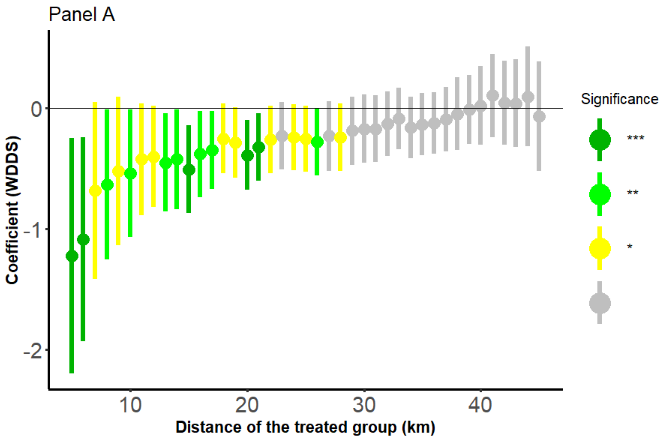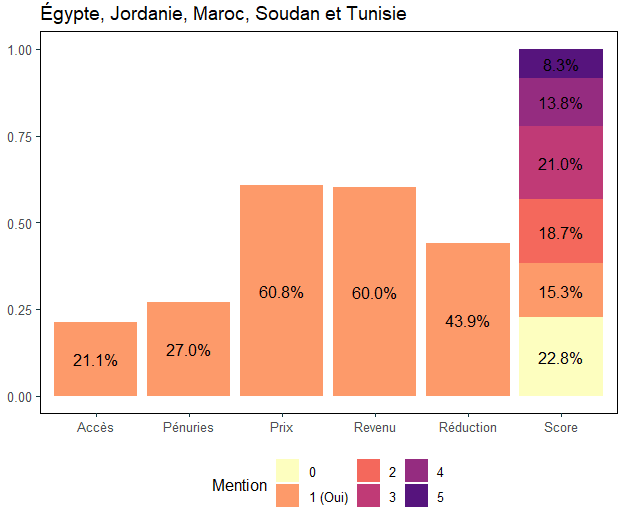Antoine Castet - Research
Publications

- The impact of large-scale land acquisitions on food security
in Africa.
World Development 179, July 2024. PDF
Abstract: Food insecurity is a major concern in most African countries. Large-scale land acquisitions (LSLAs) frequently have a negative impact on local communities. In this paper, I examine the impact of LSLAs on the nutritional status of neighboring children. To this end, I use a difference-in-differences methodology applied to LSLAs in a large number of African countries at different times since the early 2000s. I analyze data from Demographic and Health Surveys combined with data from the Land Matrix Initiative, supplemented by my own research, ultimately covering 18,276 children living in the vicinity of 45 LSLAs. I show that LSLAs have had a significant negative impact on child nutrition in Africa over the past two decades. Specifically, the dietary diversity scores of children living close to LSLAs were reduced by 20 per cent after acquisition. The results are robust to various statistical tests. I find no changes in work status or household assets. While the impact of LSLAs may be positive for agricultural practices, it is negative for child food security. The analysis highlights the importance of supporting local communities following foreign agricultural investment.

- Food security and Covid-19: An analysis of the MENA
region, with Racha
Ramadan.
Revue d’Économie du Développement, 33(3–4), 2023. PDF
Abstract: We study the food situation of households in five countries in the Middle East and North Africa region during the Covid-19 pandemic. We show that household food security was negatively affected during the pandemic.
Working papers
- Heterogeneous impacts of large scale land acquisitions on
child nutrition in the Global South, with Julie
Faure, Leonardo
Bertassello, Davide
Danilo Chiarelli, Sandra
Eckert, Kyle
Frankel Davis, Jampel
Dell’Angelo, Paolo
D’Odorico, Maria
Cristina Rulli, Bhoktear
Khan, and Marc
F. Müller.
R & R at Proceedings of the National Academy of Sciences.
[+] Abstract
Transnational land investments have surged in recent decades, reshaping rural landscapes in low- and middle-income countries. These large-scale land acquisitions (LSLAs) often displace smallholder farming and natural ecosystems, disrupting local food, water, and environmental systems. Yet, the ways these socio-environmental changes interact to affect household well-being remain poorly understood. We present a global analysis of over 400 georeferenced land deals, using a clustering algorithm to characterize cross-dimensional trade-offs and define LSLA archetypes with distinct policy relevance. Linking these to data from more than 84,000 children in Demographic and Health Surveys, we find that impacts on dietary diversity vary widely across archetypes, shaped by prior land use, water availability, and investment intent. The most severe adverse effects occur when LSLAs involve conversion to cash crop or plantation agriculture. In contrast, some deals-particularly those in already intensive agricultural regions-show potential to enhance dietary diversity, likely through spillover economic benefits. However, these gains vanish under conditions of water scarcity. Strikingly, we find a persistent association between water scarcity and negative nutritional outcomes, suggesting that water grabbing is a common and consequential feature of LSLAs. Our findings challenge the notion of LSLAs as uniform interventions and highlight the need for more differentiated, context-sensitive policy responses. Regulation should target the specific socio-environmental trade-offs associated with different types of land deals to better safeguard household well-being in affected regions.
- Climate Change and Gendered Structural Transformation in
Africa, with Kibrom
Abay and Martin
Paul Jr.Tabe-Ojong.
R & R at Journal of Development Economics.
[+] Abstract
We examine whether and how climate change affects structural transformation in Africa. We also examine potential gendered impacts as well as heterogeneities across different population groups. Combining census data covering 12 African countries and four decades (1974–2014) with gridded temperature and precipitation data, we document that a 1\(^{\circ}\)C increase in decadal temperature increases employment in agriculture by about 6 percentage points while triggering a comparable decline in the share of employment in nonagricultural sectors. We also document heterogeneities in the impact of climate change and show that climate change leads to a gendered delay in structural transformation, with women and less-educated individuals more affected by the delay induced by climate change. These findings suggest that climate change can aggravate existing inequities in societies. We provide empirical evidence on potential mechanisms, including impacts through agricultural productivity and labor force participation. Medium-term increases in temperature reduce agricultural productivity while increasing demand for farm labor and hence labor force participation.
- The conquest of the desert: Land investment in
Egypt.
Job Market Paper
[+] Abstract
In Egypt, demographic pressure is pushing people to populate and farm the desert. To foster economic development, the government is incentivizing these pioneers to settle there and contribute to the expansion of agriculture, manufacturing, and services. The desert concentrates the dreams and hopes of a country facing many challenges. My study uses census and satellite data to analyze the effects of this expansion policy. To assess its impact on structural transformation, I employ a difference-in-differences strategy, comparing districts bordering the desert to inland districts, before and after the implementation of a law that accelerated the expansion. Census data, available from 1960 to 2017, allow for long-term observation. Districts with access to the desert, which enabled agricultural land expansion, experienced a relative increase in the share of agricultural employment, accompanied by a relative decline in employment in manufacturing and services, compared to other districts. These districts have specialized in the sector where they have a comparative advantage, agriculture. The Egyptian expansion policy, instead of fostering the growth of the manufacturing and services sectors, slowed down the structural transformation of these districts relative to those inland.Book chapter
- Past, Present and Future of Food Security in Egypt, with Racha Ramadan, in Pathways to African Food Security: Challenges, Threats and Opportunities towards 2050, edited by Michiel de Haas, and Ken E. Giller, 2025. PDF
© Antoine Castet · Built with R Markdown